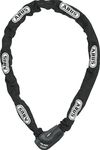Buying Guide for the Best Abus Bike Locks
Choosing the right bike lock is essential for keeping your bicycle safe from theft. There are many types of locks, each with their own strengths and weaknesses. When picking a bike lock, it's important to consider where and how you'll be using it, how much security you need, and how convenient the lock is to carry and use. Understanding the key features of bike locks will help you make a choice that balances security, ease of use, and practicality for your daily routine.Lock TypeThe type of lock refers to the design and mechanism used to secure your bike. Common types include U-locks (also called D-locks), chain locks, folding locks, and cable locks. U-locks are generally considered the most secure and are best for high-risk areas, but they can be heavy and less flexible. Chain locks offer flexibility and can secure your bike to larger objects, but their security depends on the thickness and material of the chain. Folding locks are compact and easy to carry, offering a balance between security and convenience. Cable locks are lightweight and flexible but offer the least security, making them suitable for low-risk situations or as a secondary lock. Choose the type based on where you park your bike and how much security you need.
Security RatingSecurity ratings are often provided by the manufacturer or independent organizations and indicate how resistant the lock is to theft attempts. Ratings usually range from basic to high security. Basic security locks are suitable for quick stops in low-risk areas, while high-security locks are designed for long-term parking in public or high-risk locations. Consider how valuable your bike is and where you usually leave it; if you park in busy urban areas or leave your bike unattended for long periods, opt for a lock with a higher security rating.
Shackle or Chain ThicknessThe thickness of the shackle (for U-locks) or chain is a key factor in how difficult the lock is to cut or break. Thicker shackles and chains are harder for thieves to cut with bolt cutters or saws. Thickness typically ranges from around 8mm to over 16mm. For high-risk areas, look for a lock with a shackle or chain thickness of at least 13mm, as this provides strong resistance to most hand tools. For lower-risk situations or lighter use, a thinner lock may be sufficient and easier to carry.
Locking MechanismThe locking mechanism refers to how the lock is secured and opened, such as with a key or a combination code. Keyed locks are common and generally more secure, but you need to keep track of the key. Combination locks are convenient since you don't need a key, but they can be less secure if the code is simple or the mechanism is weak. Think about your preference for convenience versus security, and whether you are likely to lose keys or forget codes.
PortabilityPortability is about how easy it is to carry the lock with you while riding. Heavier and bulkier locks can be more secure but may be inconvenient to transport. Some locks come with mounting brackets for your bike frame, while others are designed to fit in a bag or wrap around your seat post. Consider how far and how often you ride, and whether you need a lock that is lightweight and easy to carry, or if you can manage a heavier, more secure option.
Length or SizeThe length or size of the lock determines what you can secure your bike to and how many parts of your bike you can lock at once. Longer chains or cables can wrap around larger objects or lock both wheels and the frame, while shorter U-locks may only fit around the frame and a bike rack. Think about the types of places you usually park and whether you need extra length to secure your bike properly.
Weather ResistanceWeather resistance refers to how well the lock can withstand rain, snow, and other elements without rusting or becoming difficult to use. Locks with protective coatings, rubber covers, or stainless steel parts are better suited for outdoor use and will last longer. If you often leave your bike outside, look for a lock that is specifically designed to resist weather and avoid locks that may seize up or corrode over time.

















